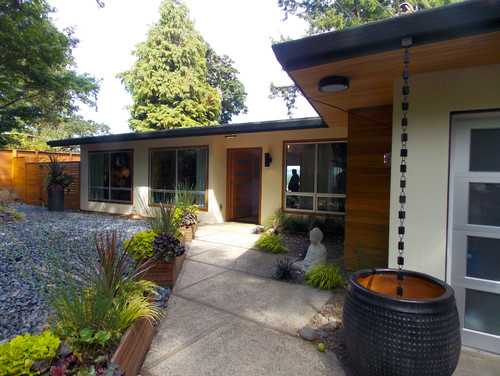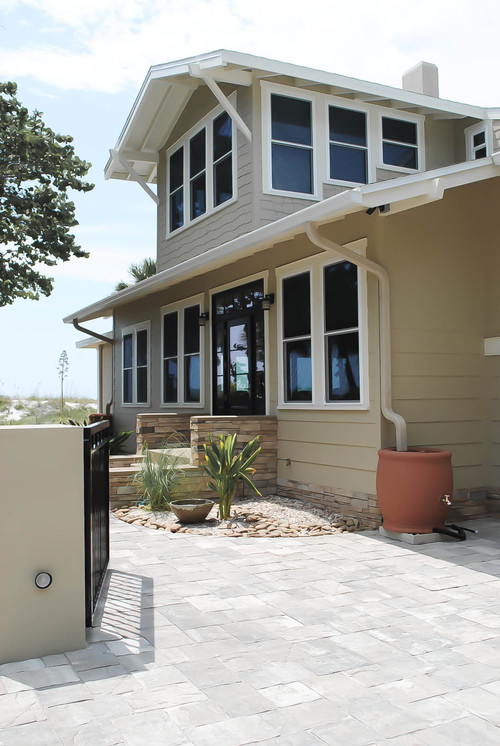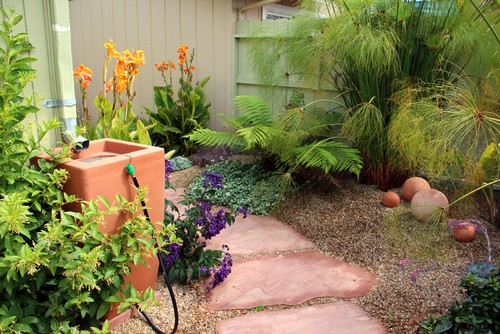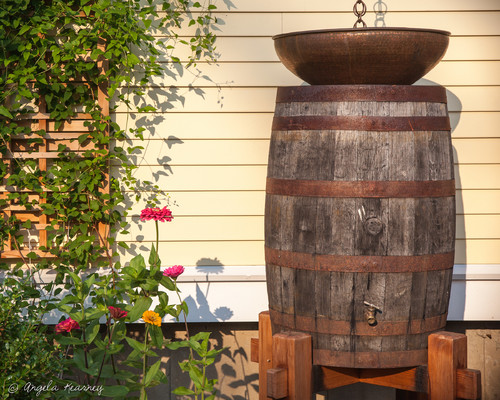Rainwater capture and storage during the rainy season is a smart, forward-thinking way to deal with drier times. It’s easy and affordable to install a rain barrel and will make your plants and soil happy. Read on to discover more reasons to store your rainwater now.
See More Innovative Deck Designs
1. Storage is easy. With the help of gravity, a well-placed rain barrel collects roof runoff without any bells or whistles. Purchase a premade barrel with all the components included, or create one yourself. Connect a downspout to the container, or use a rain chain to move water from the roof gutter to your barrel.
If you’re buying or building your rain barrel, make sure it:
○ Has a screen for filtering out debris
○ Is made of opaque material to keep the water in darkness (light allows bacteria and algae to grow)
○ Is clean, or can be easily cleaned if it’s being repurposed; look for food-grade barrels, and stay clear of any that have previously stored toxic stuff
○ Has a spigot for easy access
○ Has an overflow mechanism for when the container gets full
Tip: Before you purchase or install a rain barrel, be sure to check local laws. Certain states have issued rainwater-harvesting restrictions, with Colorado virtually banning it.
2. You’ll have a free supply of water when you need it. When that next dry spell or drought comes along, you’ll be glad you have access to free irrigation water to help see your plants through to the next rain. The larger the storage container, the longer you can irrigate your garden during extreme drought. In drought-prone regions, even native and drought-tolerant plants can die off during extra-long dry periods.
10 Drought-Tolerant Shrubs That Thrive in Full Sun and Reflected Heat
You can store water in a rain barrel or cistern without worrying that it will go bad. As long as the water is kept in darkness and no algae or bacteria grow, you can harvest the water for non-potable uses such as irrigation. Underground cisterns are especially good for storing water for extended periods, even several years. The barrel does need to be cleaned periodically.
3. It’s easy on you and your budget. Start-up costs for a rain barrel can be pretty minimal, depending on the size and material. A standard 50-gallon plastic barrel runs about $100 at the hardware store, and some local governments subsidize the barrels, allowing you to purchase them for a nominal fee or even snag one free.
It’s easy to start out small. The most basic rain barrel might be your entry point into water storage. You can try it out and work out any kinks, and then chain together several barrels or upgrade to a larger tank if you decide to expand. It’s a low-commitment project to start small and learn as you go.
You’ll be saving money on potable water costs because you’ll be using the stored water to irrigate your garden instead of water from the tap.
4. Rainwater is better for soil and plants. Rainwater is the preferred water for plants and soil because it’s cleaner and softer than most city water. Municipal water has trace amounts of salts and minerals that can build up in soil, especially in areas with infrequent rain.
Avoid collecting pollutants from car exhaust, roofing materials and other environmental sources by using a “first flush” diverter for your barrel. This device diverts the first batch of roof runoff, which is the dirtiest.
5. There are numerous environmental benefits. Rainwater storage is the first step at intercepting stormwater runoff. Stored rainwater used to irrigate the garden percolates through the soil, which allows nature to clean the water, as opposed to it running as dirty water directly into local water systems, which degrades water quality and can lead to flooding and erosion downstream. It also takes the stress off aging infrastructure.
How does one little barrel make a difference? If more homeowners store and intercept rainwater using barrels, swales and rain gardens, local environments and water quality will improve. It’s a small change that, when replicated by many people, can have a large positive impact.
6. Many rain barrels look good and the ugly ones are easily hidden. Many basic barrels, like the rustic one shown here, add to a garden’s look while saving water. If you decide to go for a basic plastic barrel, you can easily hide it by tucking it behind a vine-planted screen.
Rainwater Harvesting with Leaffilter
If you are looking to harvest your rainwater, there’s no better system than LeafFilter Gutter Protection. LeafFilter Gutter Protection prevents leaves, debris, shingle grit — everything but water — from entering and clogging your gutters. This way, you can harvest clean and clear water to use however you see fit! And, you’ll never have to clean your gutters again. Request a free estimate from LeafFilter today.







